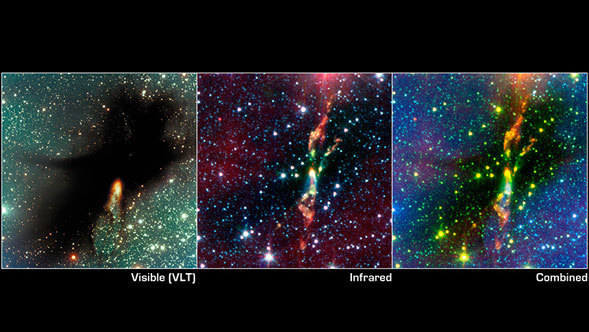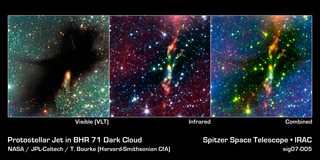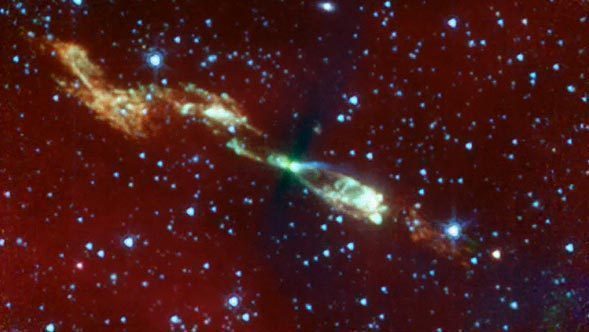
News Release • May 1st, 2007 • feature07-04 •
Written by Linda Vu
Spitzer Science Center
Rainbow-colored jets in the cosmic cloud BHR 71 point to a celestial smash occurring 600 light-years away from Earth -- and NASA's Spitzer Space Telescope provides an exclusive peek at the "jet-setting" stars inside.
The hot, young-stars can be seen in the Spitzer image (middle panel) as yellow spots with dual rainbow-colored jets shooting out of them -- one from the top and one from the bottom of each star. The colors in the jets represent infrared light: green reveals really hot hydrogen gas, orange shows warm gas, and the wisps of red represent the coolest gas. These infrared rainbows of color are exposed when shockwaves from the stars violently smash into surrounding gas and dust.
"Spitzer offers a spectacular view of this region. In space, there are only a handful of places where we can see the chemical effects of stellar outflows on the surrounding cloud -- and we see that in this Spitzer image," says Dr. Tyler Bourke of the Harvard-Smithsonian Center for Astrophysics, Cambridge, Mass.
The gas closest to the hot young-stars is heated most because the high-energy shockwaves collide into these particles with incredible force. As the shockwaves travel away from the star, resistance from gas and dust particles along the way reduces the shockwaves' momentum -- so collisions with material further out are not as intense -- and gas is not heated as much.
Because green gas toward the beginning of BHR 71's jets is hotter than the orange gas near the middle, Bourke thinks that the cloud's "starlets" are shooting off energy in regular bursts. He notes that if these stars had only shot off one burst of energy, then the gas closest to the star would be the coldest. The logic behind this is that closely orbiting dust and gas would have more time to cool as the shockwaves traveled further away from the star. In this scenario, the material toward the middle of the jet would be warmer because shockwaves from the burst would have traveled away from the star, and currently be colliding with molecules that are further out.
"Astronomers believe that all young stars at this stage of evolution [or development] produce jets. However, we don't always see these jets because they need a dense environment -- with a lot of gas and dust -- to run into," says Bourke. "We also need infrared telescopes to measure heat created when the jets' shockwaves collide with gas molecules."
For years, stars inside BHR 71 have evaded the prying eyes of visible-light telescopes. In an optical image taken by the ground-based Very Large Telescope (left panel), BHR 71 is just a large, black cloud. A burst of yellow light toward the bottom of BHR 71 is the only indication that jet-setting starlets may lurk inside.
Before the Spitzer observations, astronomers suspected that this optical rupture was a hot young star's powerful jet breaking through the dense structure. This theory was confirmed when scientists combined the visible-light view of BHR 71 with Spitzer's infrared view (right panel). In this composite, the visible-light jet overlaps exactly with a jet spouting-out of the left star, in the infrared image.
The combination of views also exposes a "crowd" of stars that escaped visible-light detection. Yellow dots scattered throughout the image are young stars forming inside BHR 71. Spitzer also uncovered another jet-setting star located just to the right of the powerful jet-setting star seen in the visible light image.
Spitzer was able to see details that visible-light telescopes didn't, because its infrared instruments are sensitive to "heat."
Bourke is the lead author of a paper on BHR 71, which is being prepared for publication in the Astrophysical Journal.






